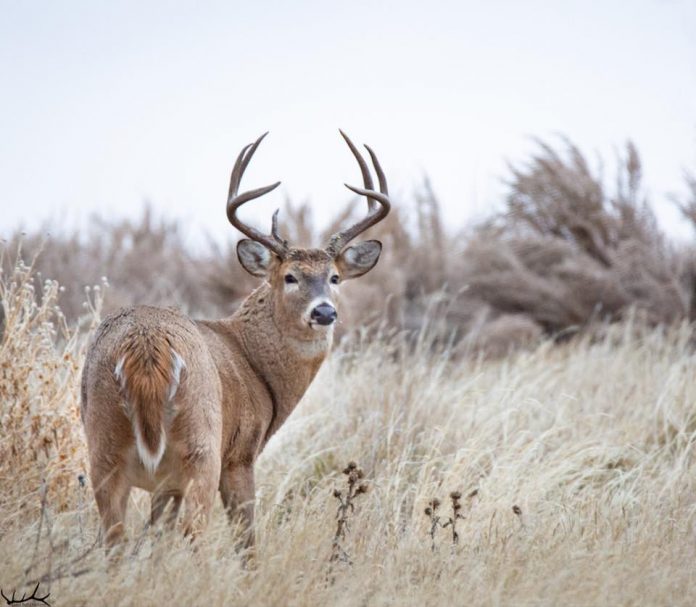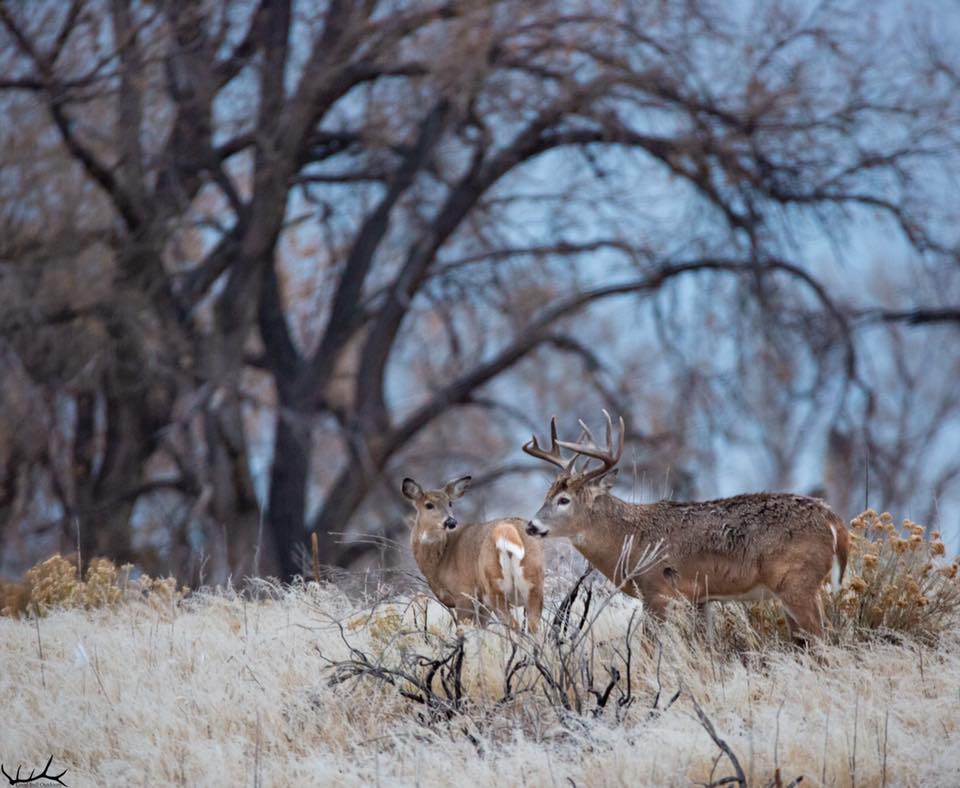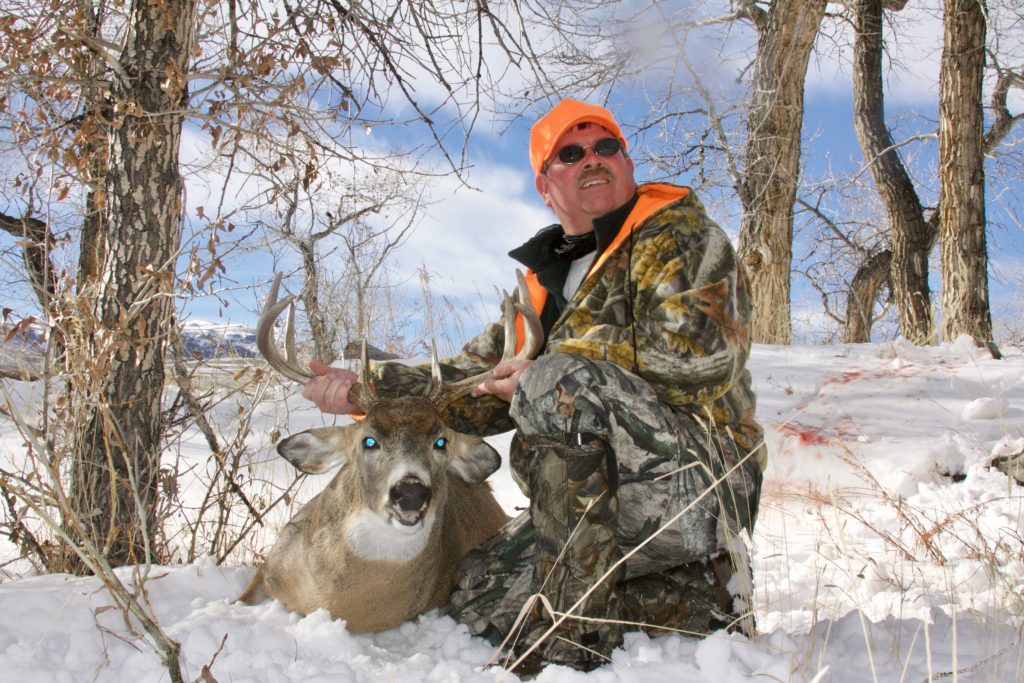
The Rut
Access was limited. The ability to travel developed roads was not an option – the snow was far too deep. But the rut was in full force – mature whitetail bucks were moving – we saw too many to count from our high ridge perch through trusty optics.
“What do you think?” My question was directed at Dad, my all-time favorite hunting partner and the man responsible for my passion and this way of life.
Together we had notched over a decade of chasing western whitetails – learning and growing wiser with each year. The learning, growing and thriving pursuit with Dad is easily one of the most memorable and cherished journeys of my life.
Our initial motivation to chase whitetails was a bit naïve and a little far-fetched. To us, they were locusts, here to invade the territory that rightfully belonged to the native mule deer. We had watched the decline of mule deer numbers as the population of whitetails grew in different areas we hunted.
The Beginning
In the beginning, we made the same fatal mistakes most rookie western whitetail hunters make – we assumed the tactics would be similar to that of hunting mule deer. Only, it would be easier – had to be. Mule deer were in the rugged high elevations of the Rocky Mountains, whitetails were flat land dwellers – they ran with the pheasants and other upland game birds.
Too easy, we fooled ourselves – too easy.
As the years, the miles and the hunts grew, we found our self-glorified mission and wild goose chase of eradicating whitetail in native mule deer country to evolve into something else, something more. We developed a deep understanding and respect for these elusive ungulates. It turned in to a passion – an incurable addiction of the pursuit. We found ourselves eating, breathing, and dreaming of whitetails.

We learned quickly that our adversary was cunning, masters of concealment and demonstrated behaviors we’d never seen chasing their cousins, the mule deer. In a word – they were ghosts.
To initially help our endeavor, we read books by the greats of the sport, found ourselves watching nightly the whitetail hunts on various popular outdoor hunting channels.
Adapting
We would adopt some of the technics. We were able to find some that worked – and others, not so much. However, it wasn’t far into our personal search for growth as whitetail hunters that we learned unequivocally that there is a huge difference between hunting eastern whitetails and those found in large agricultural fields – and the whitetails we were pursuing in our backcountry.
Whereas there is a plethora of print and video on the pursuit of eastern whitetails, when Pops and I started our journey – there were few written words of the pursuit of western whitetails.
We had to learn, evolve on our own. Hunting being the passion and lifestyle it is to us – our identity – we could not have asked for a greater challenge or quest.
“So, what do you think?” I asked again. But knew the answer, as did he. And just needed confirmation. I was younger and more adventuresome, there wasn’t a critter I wouldn’t go after – he was more prudent and quicker to calculate the end result and pack out.
The backdrop for this conversation was sitting in a spot that proved to be advantageous for us as whitetail hunters. Perched high atop a ridge, glassing down into the whitetail habitat.
Whitetail U
We called it our school – Whitetail U, the place we learned the most. We spent countless hours with optics to eyes just watching and learning. It was here that we started to pick up the habits and moving patterns of the deer we pursued. We would watch a mature buck bed in thick cover at daybreak – and then subsequently watch other hunters walk within feet of the bedded buck, who would never move – nerves of solid steel.
Shortly after the oblivious hunter left eye site of the wiser animal, he would simply stand and sneak his way to another hiding spot.
And that’s exactly what they did – the only word that can come to mind – sneak. When we first started hunting whitetails, the impression we had were flighty animals waving a warning white flag for all to see as they ran away. But, we quickly learned there is nothing flighty about a mature buck – and the way he moves is that of a master tactician using his cover and concealment with impressive skill.
It is this understanding that made us realize, we can’t simply pursue them. We have to pattern them, we have to know the spots they use to hide, we have to study him in a way that we can predict his movement and whereabouts when we leave our high elevation vantage point and enter his labyrinth of passes and hideouts.
Hunting is patience – its an essential part of your toolkit of skill sets. Never is this more important than during the quest of a mature whitetail buck. Study, learn, pattern, and anticipate.
Strategy
In the west, you have a distinct advantage in this category. Most whitetail country is surrounded by rolling hills, ridges and mountains. Places of high elevation with a crystal-clear view into their backyard. Invest in good optics, and plan a day or two or more of intel gathering.
With this strategy, you get to kill two birds with that one proverbial stone. First, you can find the buck you want – put yourself in a more realist scenario to harvest him. Second, you get the opportunity to watch and learn. I’ve decided the day I’m no longer learning in the field is the day I hang up my boots.
Three days – we had sat in the same spot for three days. We had done our homework, research was complete, it was time to move.
“So?” The barrier was the walk in. It would be between six and seven miles by our calculations, and the wind would be crucial to our success or the prominent reason for our failure. It’s been said often if you don’t like the weather in Wyoming, wait awhile – it will soon change.
The same can be said of the wind. I cannot count the number of times a last second wind direction change cost me and those I’m blessed to hunt within the field.
Sensing my eagerness – and tired of the questioning, Pops finally relented. “Let’s do what we came here to do,” quoting the iconic Colonel Hal Moore from the movie “We Were Soldiers.”
While glassing from a high vantage point, it is imperative that you study the lay of the land you are about to enter. Look for identifying landmarks, trees, brush, things that can alert you to where exactly you are and more importantly where he is bedded. Obviously, when you move from an elevated position to eye level with the buck, nothing looks the same.
Patience
Stealth and patience are your friends. How you walk and keeping a mindful attention on wind is critical. An unfamiliar scent in the wrong direction can leave you quickly looking at the south end of a northbound mature whitetail buck.
As you get closer to the area you know to hold the buck, your steps should be more deliberate, and glassing is more frequent. Of course, as I tell my kids when teaching them how to glass, you’re looking for tips and eyeballs.
Dad and I had an advantage on this day. It was the middle to late part of November, the bucks, our buck was on his feet. We just had to locate him.
When moving towards the location you’re headed, remember the outliers. There are other whitetails, mule deer, sometimes elk in areas (we’ve encountered grizzly bears in the past on our walks in) – spooking any of those mentioned could send them out of the countryside with your buck of a lifetime in tow.
“Stubby” as he would forever be referred to was pushing a doe when we finally got to him. The wind was in our favor the entire time, and the buck we’d watched from miles away was now within 100 yards of us. He had no clue we were there. The cover was thick, seeing 100 yards was almost a stretch.
Success
Dad leaned next to a sturdy tree and put his trusty Ruger Number 1 .300 Weatherby on fire. When Stubby offered a broadside shot, dad squeezed the trigger. The blast echoed through the river bottom, Stubby took a couple half-hearted steps and fell to the ground. It was the biggest buck dad had shot to that moment, or since in our pursuit of whitetails.

It was the culmination of years of groundwork; countless hours of studying, reading, glassing, and learning. It was an emotional moment, and an unforgettable hug from my personal hunting hero and life icon.
Dad, Stubby and I stood there for a long time – no movement, no words – we just soaked in the moment. We knew it was special, and there may never be another like it. My life, like most young men, was built on making my Dad proud. But that day I could not have been prouder of him. He worked his tail off – he earned that trophy.
Stubby now hangs on Pop’s wall in his TV room. Standing at the bar in the open floor plan of the main living area of his house I catch myself looking at that old buck now and again – remembering that moment. It’s something neither of us will ever forget.
There was more to this hunt. The pack out was tough and memorable, no question. Stubby was over 250 pounds, a behemoth bodied buck. Two days later I harvested my whitetail buck, a quality five-point deer. I actually had to use the creek bottom in freezing weather to get in range for the shot. But all are stories for another day – and they both pale in comparison to that moment standing next to Pops looking at Stubby, knowing what it took to get there.
Moral of the Story
It was the end of an unforgettable journey. A decade of patience, perseverance, occasional heartache and hardship and above all, hard work.
It was a unique experience and bond. From our initial misguided view of the whitetail to the tremendous respect and admiration we adopted for them. Thinking outside the box, looking at something with an open mind and a willingness to learn and adapt were primary forces in the events of that day.
Instant gratification is the buzzword I hear these days all too often. And it’s absolutely achievable in all aspects of life – hunting is not immune. The technologies, modern off-road vehicles, land accesses for fees, etc. can net a trophy critter with little effort or work.
But, if you have the opportunity, if you have the patience and the will – do it the right way, the reward is far greater. In this sport, much like all sports, we start as novices. Our most valued learning lessons are the failures along the way. There were undoubtedly tips and tricks picked up that Pops and I clung to. But the majority was learned through the old-fashioned school of hard knocks and trial and error.
Hunting is a process, its an evolution – no matter the prey. Learning lessons along the way is the foundation for the respect that all hunters should have for the animals we pursue. Because then and only then can we deem ourselves somewhat worthy of such a grand way of life.














